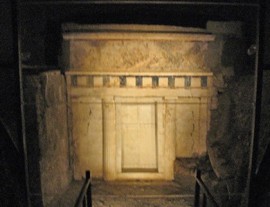The Touristic Info Halkidiki informs - Excursions and tours on Halkidiki
Animated and up-to-date

Holidays and more go China
After long and arduous negotiations, we have completed the first contract with a Chinese travel company from Chengdu a 5 million city in China. We hope for good business and have met the Chinese as friendly and professional business partners. The program for the travelers from China consists of 2 days Athens, Meteora, Delphi, Thessaloniki and last but not least. The Chalkidiki with their unforgettable sandy beaches The educational trips are rounded off with a visit to the monastic republic of Athos.

Holidays with our pets
For all guests who do not want to do without their dog during their well-deserved vacation, there is this category.

Coming soon the dream villa Eden
The Villa Eden, a unique composition of taste, elegance, exclusivity and luxury in one of the most beautiful regions of Greece, with a view of the monastic republic of Athos. Villa Eden has repeatedly been the hot spot for fashion photographers. Also for international films you will be used as a movie set. An unforgettable experience.

Beach Villas Blue Waters
Our Beach Villas are located about in halkidiki sithonia at Ormos Panagias 50 metes from the fine sandz beach. We offer in house beach chairs , canopies or umbrellas . Our tastefully and luxuriously appointed villas offer WIFI , international television , kitchen , multiple air conditioners , dishwasher and private garden .

Motor boat for self-driving.
The most successful day trip of the last years.
- Blue Lagoon - the original
- The pirate nest Pirgadikia
- Stonecutter beach - unbelievable
- Into the sunset - fascinating

Ticketbooking for your pirate tour !
Book your tickets for your pirate tour to Mount Athos or for a swimming tour online and save up to 20%.

The Road House.
To the Holidays and More company also belongs one of the most beautiful beaches in Psakoudia. There we run Road-House.

Holidays and more now on Youtube.
Visit our Youtube channel and explore our videos of Chalkidiki.

Die Holidays and more on the road
Holidays with your beloved Harley.
Unforgettable excursions, suitable accommodations and last but not least our ROAD HOUSE

Excursions in Halkidiki !
Hardly a holiday destination can offer as much as Greece and especially Halkidiki. Centrally located Psakoudia offers so many opportunities to sweaten your leisure time with excursions and activities.

Immerse yourself in the world of the Orient!
Let yourself be bathed in hot water and a lot of foam on our heated marble stones. Feel free to ask from our physiotherapists for a partial or full body massage.
Kayaking trip in the Blue Waters
Paddle a day with friends, your family or alone with our kayaks in the Blue Lagoon in Vourvourou.Turquoise blue, warm waters, powdery sand beaches and if you are lucky dolphins.An unforgettable day with pictures and experiences that are looking for the same.

Sailing with Holidays and More !
Visit with our sailing yacht the most beautiful beaches of Halkidiki and make a trip to the monastic republic of Mount Athos. Discover monks, seagulls, crystalclear water and powderfine sand. Experiences, that your will never forget.

Telephone inquiries :
0030 - 23710 - 51102
Fast, reliable and in English.
Of course we can call your back.
Journey to Vergina
The ancient city located in Vergina lied probably mainly north of the palace. The city had several sanctuaries and a theater, which was built in the second half of the 4th Century BC. The city appears to have been destroyed very badly in the first half of the 2nd Century BC.
In the area of Vergina, lie nine chamber tombs of the Macedonian period. Three graves lie under a large tumulus with a diameter of 110 m and a height of about 12 m. All three tombs are richly painted and fitted with many grave goods.
The largest grave of the great tumulus is known as Philip's grave. It is divided into a pre-and main chamber and has a facade with Ionic columns, pilasters and a frieze painted in color. The grave goods of Philip's tomb are very extensive. Both in the pre-chamber and in the main chamber was among other things, a golden Larnax, which was decorated with a star, the so-called Star of Vergina.The Larnax in the main chamber contained a golden wreath of oak and, once wrapped in a purple cloth, the burnt bones of a man.The bones are ascribed to Philip II, father of Alexander the Great. In examining the skeletal remains a healed bone wound in his right eye was found by the British anthropologist Jonathan H. Musgrave. As it is delivered that Philip II lost his right eye at the Battle of Methone 355 / 4 BC, the affiliation of the Macedon king is declared to the grave with this finding. However, this correlation is not certain. Others point out that with the dating of the tomb rather Philip III. Arrhidaios (352-317 BC), half-brother and successor of Alexander the Great, is the grave owner.
Beside the Philip's grave the prince and the Persephone grave can be found in the great tumulus. The Romaios and the Euridice's grave lie north of the palace. Four other Chamber tombs were located west of the village Palatitsa.
The tombs provide important cultural and historical references to the exposition of the Macedonian dynasty of King Argeaden.Contrary to the often held opinion, Macedonia would have lain outside of the Greek cultural sphere, the royal family presented themselves in the tombs as Greeks: grave goods show hunting and war scenes, and symposia as part of Greek life of the king's arms, and even everyday objects such as a wine mixer (which should prove that the Macedonian dynasty as the Greeks did not drink pure wine) are to be regarded as reminiscences of classical Greece, cremation and burial of the ashes of the idols of the Homeric epics.

Your rental car in Halkidiki
From the airport Thessaloniki, Hotel, Apartment and Studio in whole Chalkidiki. No credit card needed. Fast, easy and safe. For 3 days only from 63.- € !


















